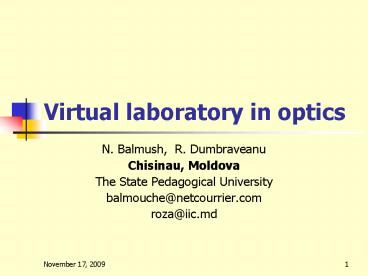Virtual laboratory in optics - PowerPoint PPT Presentation
1 / 22
Title:
Virtual laboratory in optics
Description:
Young slits, Fresnel mirrors, Fresnel biprisms. The interference. Michelson ... Fresnel and Fraunhofer diffraction from a single/double slit. The diffraction. ... – PowerPoint PPT presentation
Number of Views:95
Avg rating:3.0/5.0
Title: Virtual laboratory in optics
1
Virtual laboratory in optics
- N. Balmush, R. Dumbraveanu
- Chisinau, Moldova
- The State Pedagogical University
- balmouche_at_netcourrier.com
- roza_at_iic.md
2
Objectives of the work
- To elaborate the electronic version of the
curriculum materials in optics. - To create the interactive simulations of the
physical phenomena related to wave optics. - To elaborate the computer version of the
laboratory works with simulations of the
physical processes. - To elaborate the knowledge evaluation unit.
3
Guidelines used in the elaboration of the
computer simulations
- Learning paradigm to simulate the physical
phenomena as in real life - Constructive approach to learning
- Interactivity as motivation for learning
- Record of the students reports
4
The course Wave Optics
- The course is designed for undergraduate students
- The course comprises
- theory, problems, exercises for auto evaluation
- simulations of the physical phenomena
- laboratory works
5
Wave Optics Topics
- The interference. The study of Newton rings.
- The interference. Young slits, Fresnel mirrors,
Fresnel biprisms. - The interference. Michelson interferometer.
- The interference. Fabry-Perot interferometer.
- The interference. Rayleigh interferometer.
- The diffraction. Fresnel and Fraunhofer
diffraction from a single/double slit. - The diffraction. Fraunhofer diffraction
grating.
6
Designation of the programs
- Illustration of the concepts of wave optics
- Demo materials for the lectures
- Pre-lab works
- Virtual lab assignments
- Evaluation of the students knowledge
7
Modes of execution
- Phenomena investigation
- In this mode students have the opportunity to
model real physics experiments, to change all the
parameters of the physics installation, to
participate fully in learning new facts about the
natural world. This kind of participation
provides not only a strong motivation but, more
important, is the one of the way to give students
an understanding of science.
8
Modes of execution
- Laboratory assignment
- Laboratory assignment gives students the
possibility to determine some variables of the
experiment according to the task assigned to them
by teacher. - The ease of data measurement and visualisation
encourage students to become active participants
in a process. The real-time screen display of
actual physical measurements directly gives the
students the correlation with the corresponding
physical phenomena.
9
Lab assignment evaluation
- The assignment is generated by the program in a
random way, but fixed for every student. The
teacher has access to the text file in which the
student login data and the assignment data are
stored. - The comparison of obtained data with those from
the text file is a useful pedagogical tool for
evaluation the correctitude of the fulfilled
measurements.
10
General view for simulations
11
Lab assignment for the student
- The assignment is generated by the program in a
random way, but fixed for every student. - The teacher has access to the text file in which
the student login data and the assignment data
are stored.
12
The study of the Newton rings(the installation
scheme)
13
The study of Newton rings interference picture
generated by computer simulation
14
The study of Newton rings demo
- The presented wave optics simulations are
accessible through CD-ROMs or university
Intranet. - They can be available via Internet as executable
modules. - The demo version of the simulation Study of
Newton rings as executable module.
15
Study of interference Rayleigh interferometer
16
Study of interference Fabry-Perot interferometer
17
Study of interference Michelson interferometer
18
Study of interference Young slits
19
Use of the elaborated modules
- The simulations have been used by students from
the physics department of the State University of
Moldova. - Circa 200 undergraduate students have used these
simulations as the pre-lab works performed
before the real experiments in the laboratory. - About 50 students have studied these computer
programs as part of the special course
Computational Physics.
20
Conclusions
- The computer simulations have a positive impact
on the students achievements. - The students got the possibility to investigate
more deeply the physical phenomena. - The students got the possibility to simulate the
physics phenomena, to repeat all the stages of
the experiment. - Some students have enhanced their programming
skills and understanding of physical phenomena. - The elaborated modules can be used also as demo
materials during lecturesas illustration of
science concepts.
21
Proposal of collaboration
- The authors would like to collaborate with other
groups within the framework of some projects in
order to exchange ideas, to share experience and
to develop new computer units for student
education. - Contact balmouche_at_netcourrier.com
- rdumbraveanu_at_yahoo.com
22
Thank you!































